Oliver Laric and the Media Archaeology of Classical Sculpture
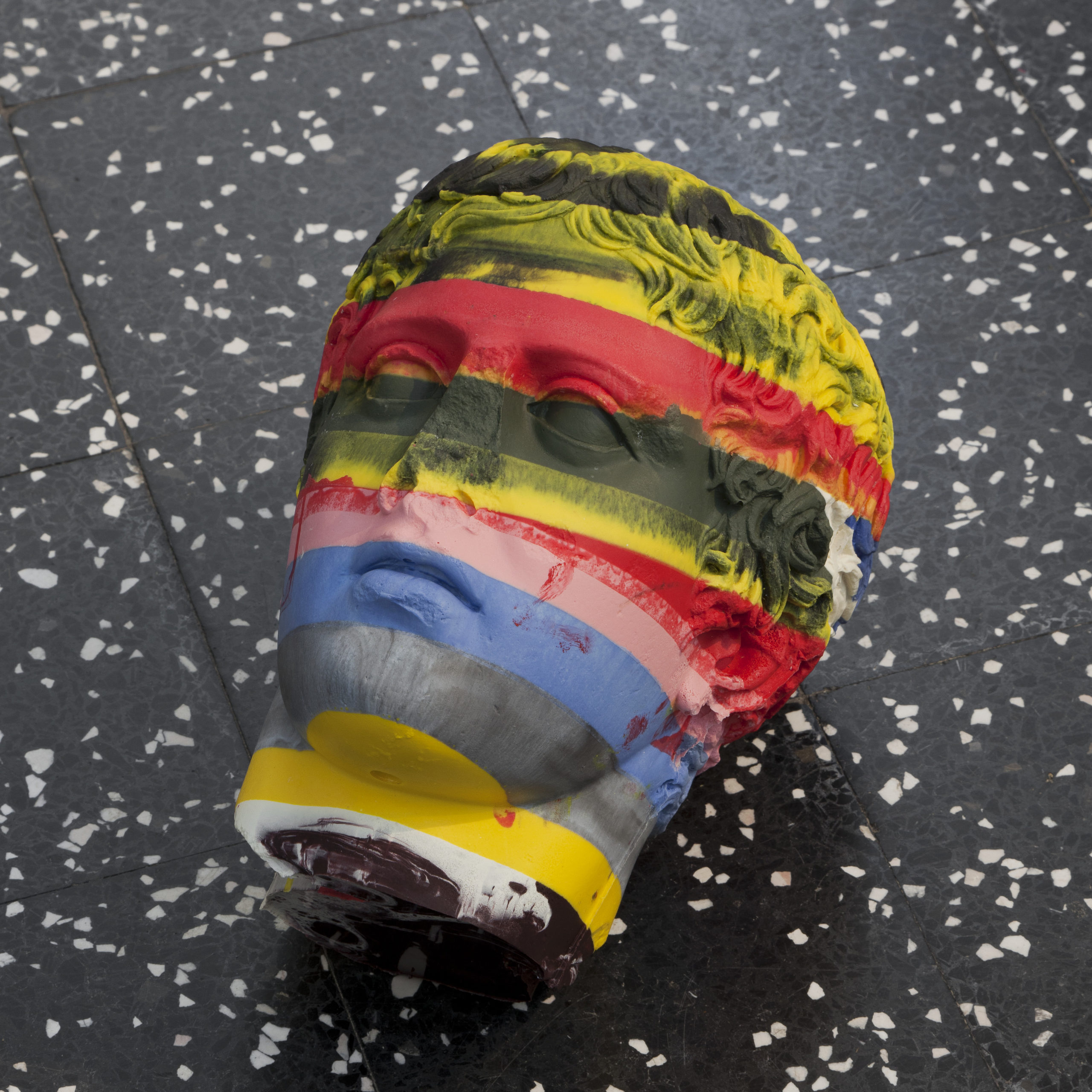
In 1657, a marble statue of a Pouring Satyr was discovered on the steps of an ancient theater unearthed at the papal estates of Castel Gandolfo, located southeast of Rome on the site of the villa of the emperor Domitian.[1] On the same steps, another, almost identical statue of a Pouring Satyr was found. And then another. And yet another (Fig. 1). The sheer visual redundancy and proximity of the four Satyrs, a type now generally attributed to an original by Praxiteles dated to the second quarter of the fourth century BCE, was immediately recognized as a critical aspect of their collective value.[2] Consequently, Pope Alexander VII, born Fabio Chigi, was adamant that the set of Satyrs not be split up into various collections. But it was not to last. The group remained in the Chigi family (who commissioned sculptors to undertake Baroque restorations) until 1728, when all four were sold to Augustus II, King of Poland and Elector of Saxony, who moved them to Dresden.[3] The integrity of the Satyr group was kept intact until 1838, when the House of Wettin gave one of the Satyrs (the one missing its right arm) to the British Museum in exchange for a set of plaster casts of the Elgin marbles.[4] During World War II, the three Satyrs were relocated to the Soviet Union, which later transferred them to the German Democratic Republic. In a compensation agreement following the reunification of Germany, one of the Satyrs was eventually deaccessioned from the Dresden Museums and returned to the House of Wettin, which put it on the market; it was purchased in 2002 by the J. Paul Getty Museum.

1. Screenshot of a PowerPoint slide of the Four Pouring satyrs from the Villa of Domitian at Castel Gandolfo. Attributed to Praxiteles, second quarter of the fourth century CE. From left to right: (1) London, British Museum; (2) Dresden, Albertinum; (3) Malibu, J. Paul Getty Museum (Getty Villa); (4) Dresden, Albertinum.
The four Pouring Satyrs from Castel Gandolfo offer a trenchant example of the aesthetics of repetition in Roman art and of the stakes of classicism more generally. During the third and second centuries BCE, as the Romans conquered Sicily, Magna Graecia, Greece, and the kingdoms of the Greek East, statues like the Pouring Satyrs were requisitioned and taken as war booty amid heaps of treasure and fine art and paraded by the cartful in triumphal processions in the city of Rome. Aristocrats, and eventually emperors like Domitian, quickly assembled great collections of Greek art, sometimes in the form of originals but especially in copies—displayed either singly, as pendants, or in rare cases such as the villa of Domitian, in a genuinely serialized manner—for their sumptuous and expansive villa estates.[5] Classical archaeologists refer to this heterogeneous body of sculptural copies as Idealplastik, a category invented to identify Roman versions of Greek sculpture (some of these, like the Satyrs, being nearly identical replicas, but with slight differences that suggest they were made in different workshops; others being copies taking varying degrees of artistic license to accommodate changing tastes and conditions of display).[6] At the same time, the mixed status of the Satyrs as both ancient Roman and Baroque works of art—not to mention their recursive allusions to an imputed Greek prototype, or nineteenth-century interventions of de-restoration—makes them especially complex objects of study.[7] So too does their provenance history, which reveals the political economy in which they have operated as more or less fungible tokens of exchange. Indeed, the blockbuster show Serial Classic at the Fondazione Prada in Milan in 2015 marked the very first time that the Satyrs were reunited and displayed as a group since 1838.[8] Previously, the Satyrs were only imaginatively reassembled either in the layout design of print publications or in the scalar compositions of digital presentations, such as this screenshot of a slide from a PowerPoint purloined from my graduate advisor.
The case of the Pouring Satyrs offers a useful point of departure for the present essay, which investigates the role that Idealplastik plays in the work of Oliver Laric (b. 1981), an Austrian-born artist based in Berlin. Laric has produced a compelling body of work that manifests some of the keenest insights about the stakes of sculpture in our contemporary digital milieu. Nearly all of Laric’s sculptural output comprises 3D printed or resin cast versions of existing sculptures in prestigious collections in Europe and the UK. It is emphatically sculpture about sculpture, as visually accessible as it is conceptually recondite.[9] Appropriately enough, Idealplastik has haunted Laric’s artistic practice for over a decade. What sets his work apart from many contemporary artists who traffic in classical “references” (which constitute a substantial portion of his work, but hardly a singular or even primary focus) is that it prioritizes matters of process and technique over imagery and meaning. As I hope to show, such a strategy seems deeply indebted to the turns of different strands of media theory, but also has rich potential in terms of confronting the ideological legacy of classical forms and iconography.
In the specific case of Idealplastik, Laric’s work investigates the interpretive frameworks of scholarly discourse that have produced, and not simply discovered, the category of putative lost originals inferred from their ostensibly etiolated copies. For Laric, it seems as if the classical tout court assumes the role of the analytical prime object (to borrow George Kubler’s term) and its replica chains in a given form-class.[10] Critics often talk about artists who are “an art historian’s artist” as a roundabout way of saying that the work in question generally betrays an art-historical self-consciousness, but Laric goes well beyond this. There is a very specific genealogy of German and Austrian strands of art history embedded in his practice that are critically anchored at once in late 19th century Meisterforschung, the search for putative originals, and the early 20th century Vienna School of art history in terms of its analysis of broader cultural systems of meaning derived through a meticulously empirical approach and attention to the structure of form.[11] Indeed, it is almost inconceivable to imagine Laric’s work having its genesis anywhere else but in a Germanophone intellectual context.
Laric is perhaps best known for his online project, threedscans.com, which presents an open-ended and open-access repository of high-quality digital scans of sculpture, both originals and plaster casts, in various collections in Europe and the UK. Many of these scans draw attention to their very status as mediated information by indexing similar properties in the objects under investigation (e.g. plaster casts or photosculpture, a kind of nineteenth-century precursor to 3D printing).[12] Like many artists who work with digital scanning technologies, however, Laric tends to treat these scans as but the raw data or ingredients of the work, massaging them into something demonstrably transformative, even “unique,” without the fetishization of originality this typically entails. Indeed, the uploaded scans are already heavily, if imperceptibly, processed in collaboration with digital sculptors who also assist in their material fabrication. What we see here, and in Laric’s work more generally, is a methodical pursuit of operationalizing distinctions between analog and digital modes of representation. By “analog” and “digital,” however, I wish to identify more than a mere contrast between historical and ostensibly “new” media. Rather, my interest lies in the processual aspects of Laric’s work and his approach to the technicity of sculpture more generally.[13]
Recursive techniques of “re-objectification” from analog to digital and back again constitute a through line of Laric’s practice. More precisely, these techniques evince what philosophers of technics call ontogenesis or “individuation” that privilege dynamic processes of becoming over static states of being. The main idea has to do with the overturning of the dominant model of Aristotle’s hylomorphism, which insisted on the imposition of active form onto a pre-existing, passive substrate. Using a diverse range of examples of ontogenetic thinking drawn from a variety of disciplines, both scientific and cultural-artistic—crystallography, quantum physics, and brickmaking, to name a few—Gilbert Simondon underscored the ways in which activities of form-taking, the definition of technicity for Simondon, operate in states of equilibrium that are not stable, but metastable: crystals that grow in supersaturated solutions; the wobble between the wave and the particle; the interaction between mold and substance on a molecular level.[14] In contrast to a “closed” object that occludes an aggregation of processes, Simondon proposed a networked “open” object that “can be completed, improved, maintained, in the state of perpetual actuality.”[15]
From a media-archaeological perspective, the analysis of these ontic operations and processes is valuable for the way it sheds light on the interstices between one medium and another while simultaneously making visible the material differences in their systems of signification. Laric’s artistic enterprise engages these issues head-on through recursive, self-referential chains of operations that show how signs become information, and in turn how that information is processed, converted, stored, and transferred from one medium to another. And it is precisely through these procedures, these symbolic technologies, that Laric reveals what makes sculpture sculptural.

2. Oliver Laric, installation photograph of Ancient Copies (right), Relief (Utrecht), and Versions (2010) at Frame, Frieze Art Fair, 2010. Courtesy of the artist and Metro Pictures, New York.
I.
Ancient Copies, an early work by Laric, comprises un-editioned bootleg copies of Margarete Bieber’s Ancient Copies: Contributions to the History of Greek and Roman Art (1977). Originally stacked up in four neat piles on the floor at Frame in the 2010 Frieze Art Fair, they were shown alongside a video installation and a set of polyurethane casts of a medieval relief (Fig. 2).[16] Laric produced a PDF of Bieber’s monograph and submitted it to Lulu Press, Inc., an online, on-demand publishing company. He subsequently uploaded the PDF to his website, but the link is now broken and leads to a 404 error page, presumably a consequence of an assertion of copyright infringement. Whereas broken links are usually quickly repaired, it’s clear that such an “error” constitutes a feature, not a bug, of Laric’s practice. Significantly, however, Laric did not reproduce the entirety of Bieber’s tome, which numbers 302 pages plus a whopping 161 plates (with 911 figures), but only the images (Fig. 3). Beyond reducing the book to its most visually salient aspect (to say nothing of cutting costs), such an editorial choice effectively performs the subject of the book, producing a version of the original adapted to meet the needs of a new context. What is more, the quadrifacial form of the contiguously stacked books suggests an empty base or pedestal capable of displaying still more sculpture with stacks of books about sculpture. In this way, Laric rethinks the structural and aesthetic purpose of the pedestal in ways that go beyond Rosalind Krauss’ argument about the nomadic quality of modernist sculpture that “reaches downward to absorb the pedestal into itself and away from actual place; and through the representation of its own materials or the process of its construction, the sculpture depicts its own autonomy.”[17] While much of this rings true for Laric, his work consistently problematizes the autonomy of sculpture. In contemplating the ontological wobble between Ancient Copies (Bieber’s) and Ancient Copies (Laric’s), we begin to witness the formalization of the pedestal as platform: a site of networked distribution across mediascapes and what Megan R. Luke has aptly characterized as the “uncanny placelessness of sculpture in the digital age.”[18]
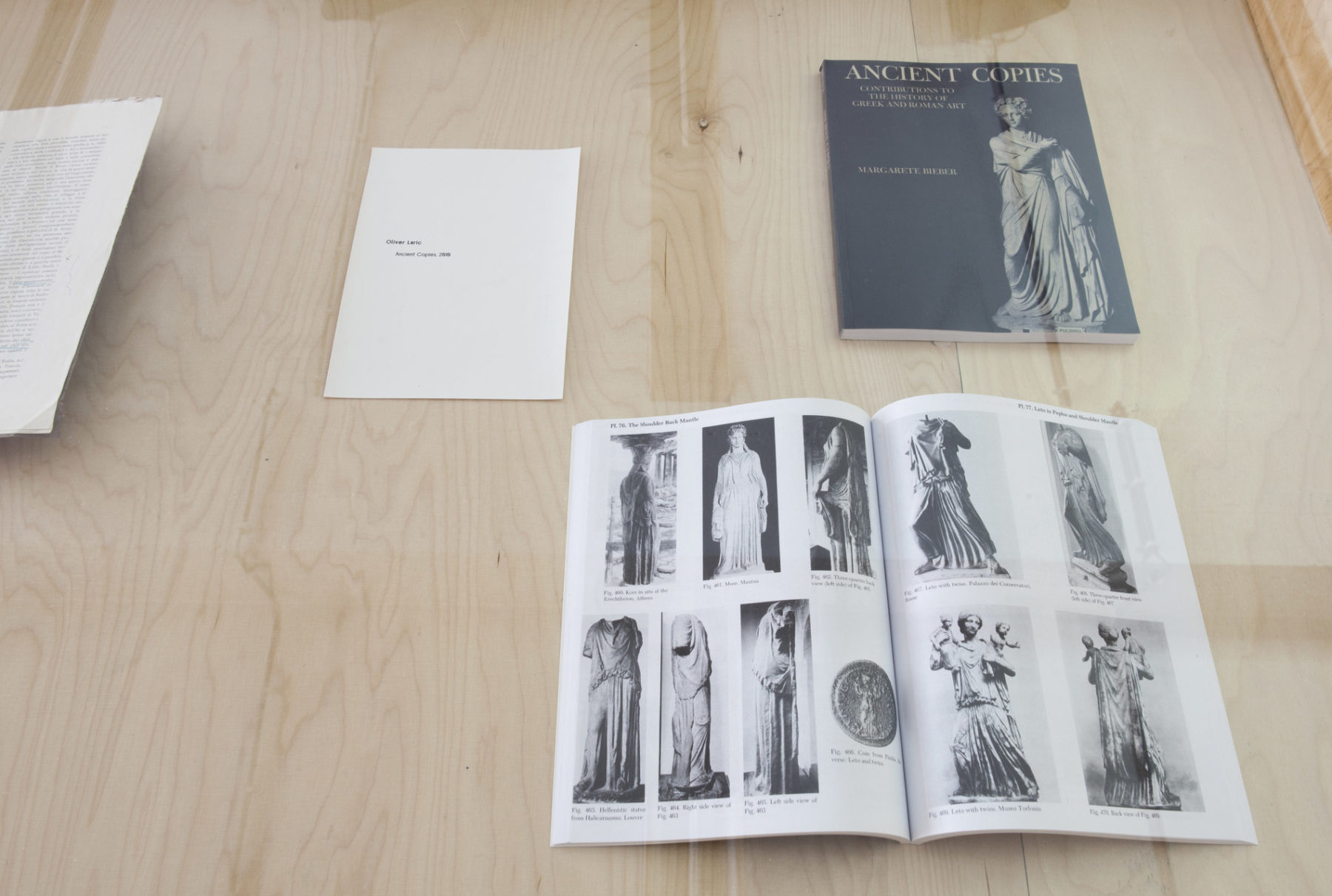
3. Oliver Laric, Ancient Copies (2010) on view at the exhibition The Camera’s Blind Spot II at the Extra City Kunsthal (Antwerp, Belgium) in 2015. Courtesy We Document Art.
The choice of Bieber’s monograph—an outdated classic among specialists, perhaps, but a classic nonetheless—as the source of these arguments about sculptural autonomy is intriguing in itself. Translation (Greek to Roman, bronze to marble, analog to digital and back again) is also rooted at the level of language and biography: Bieber was part of an early wave of German-Jewish emigres who translated a distinctively German tradition of art history and classical archaeology to the United States, where she taught at Barnard College and Columbia University. Ancient Copies marks the scholarly culmination of a long and rich life: Bieber was 97 when it was published. Bieber remarked that the idea for Ancient Copies was in fact a very old one that grew out of her early, pathbreaking research on ancient dress. And indeed, the closer one studies Ancient Copies, the more it becomes clear that it has less to do with copies than about dress. Bieber’s fundamental claim was that Roman sculptural copies (she was the first to call them “Roman,” a revolutionary move in and of itself) could be discerned by the inexpert handling of drapery that she believed was fundamentally misunderstood by ancient copyists. In order to illustrate her points, she included photographs of models posing in various states of dress and undress (Fig. 4). These models closely adhered to the so-called pose plastique that had already been made famous in tableaux vivants produced on the stage (Fig. 5).[19] What is especially astonishing here is the way Bieber’s strategy of inferring the status of sculptural copies from the execution of dress via photography and theatrical techniques of the body very closely resembles Gottfried Semper’s classic thesis tracing architectural motifs back to the textile arts—a theory that was long ago dismissed by Alois Riegl as a form of technical determinism, but which has recently enjoyed a recrudescence in so-called “German media theory.”[20] Seen in this light, her photographs of “living sculptures” evince a recursive chain of operations between first-order and second-order techniques, or between the technical and artistic dimensions of reference and self-reference.
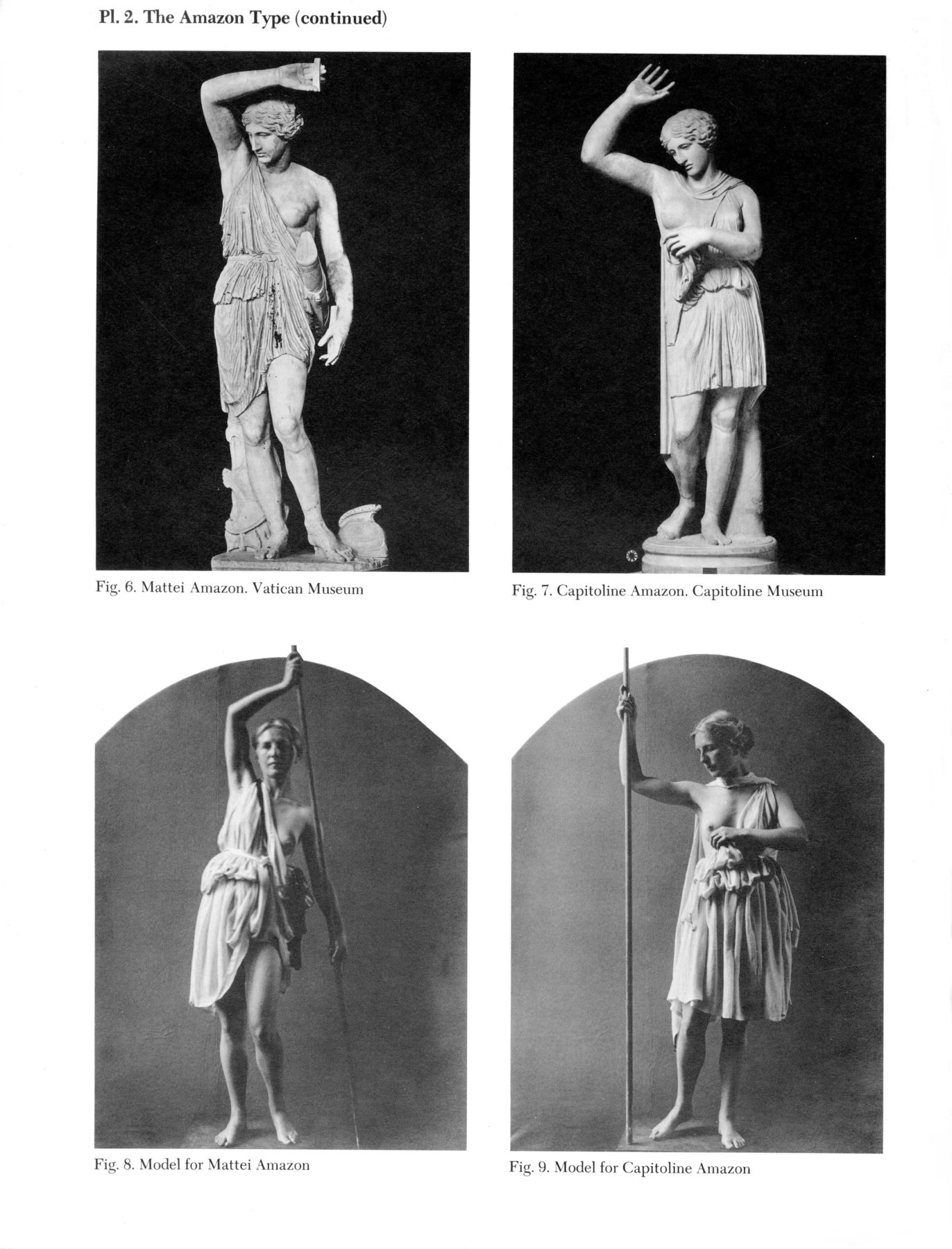
4. Plate 2 from Margarete Bieber, Ancient Copies: Contributions to the History of Greek and Roman Art (New York: New York University Press, 1977).

5. Adam Forepaugh and Sells Brothers America’s greatest shows consolidated 8 lovely ladies as living statues illustrating famous art. United States, ca. 1896. [Cincinnati & New York: Strobridge Litho. Co.] Photograph: https://www.loc.gov/item/98502456/
Beside the stacks of bootleg Bieber at Frieze was an installation of Laric’s video essay, Versions. There are several versions of Versions (2009, 2010, and 2012 so far), which is nearly impossible to summarize except to say that it investigates a vertiginous spiral of successions and recursions of images and the values that have been attached to them: these include everything from ancient sculptural copies (featuring several plates from Bieber’s Ancient Copies, but with the captions omitted) to rotoscoped animation used in Walt Disney feature films (Fig. 6).[21] Laric himself has described it thus: “a series of sculptures, airbrushed images of missiles, a talk, a PDF, a song, a novel, a recipe, a play, a dance routine, a feature film and merchandise.”[22] Laric’s mention of “a song,” “a recipe,” “a play,” and “a dance routine” among others in this Borges-like list of seemingly dissimilar items (Jorge Luis Borges, not coincidentally, is quoted at several points, from several different sources, in the video) is telling, for it reveals the extent to which his work interrogates the philosopher Nelson Goodman’s distinction between the autographic and allographic arts.[23] For Goodman, art is autographic “if and only if the distinction between original and forgery of it is significant; or better, if and only if even the most exact duplication of it does not thereby count as genuine.”[24] According to this strict Goodmanian definition, the distinction between the singular and multiple arts is immaterial: even a painting on canvas reproduced “molecule by molecule on a super-Xerox machine,” as imaginatively proposed in Gregory Currie’s thought experiment, would still be autographic.[25] Conversely, Goodman asserts, art is allographic if it is “amenable to notation.”[26] In this respect, the status of the digital image is controversial, with many philosophers arguing that digital images are indeed allographic.[27] One thinks here of the role of the algorithm—basically a set of instructions for the execution of computational operations—that plays a key role in the photogrammetry software used to process the data collected in the scanning of sculpture. But perhaps a better analogy still is Simondon’s aforementioned “open object” that, to repeat, “can be completed, improved, maintained, in the state of perpetual actuality.”[28]
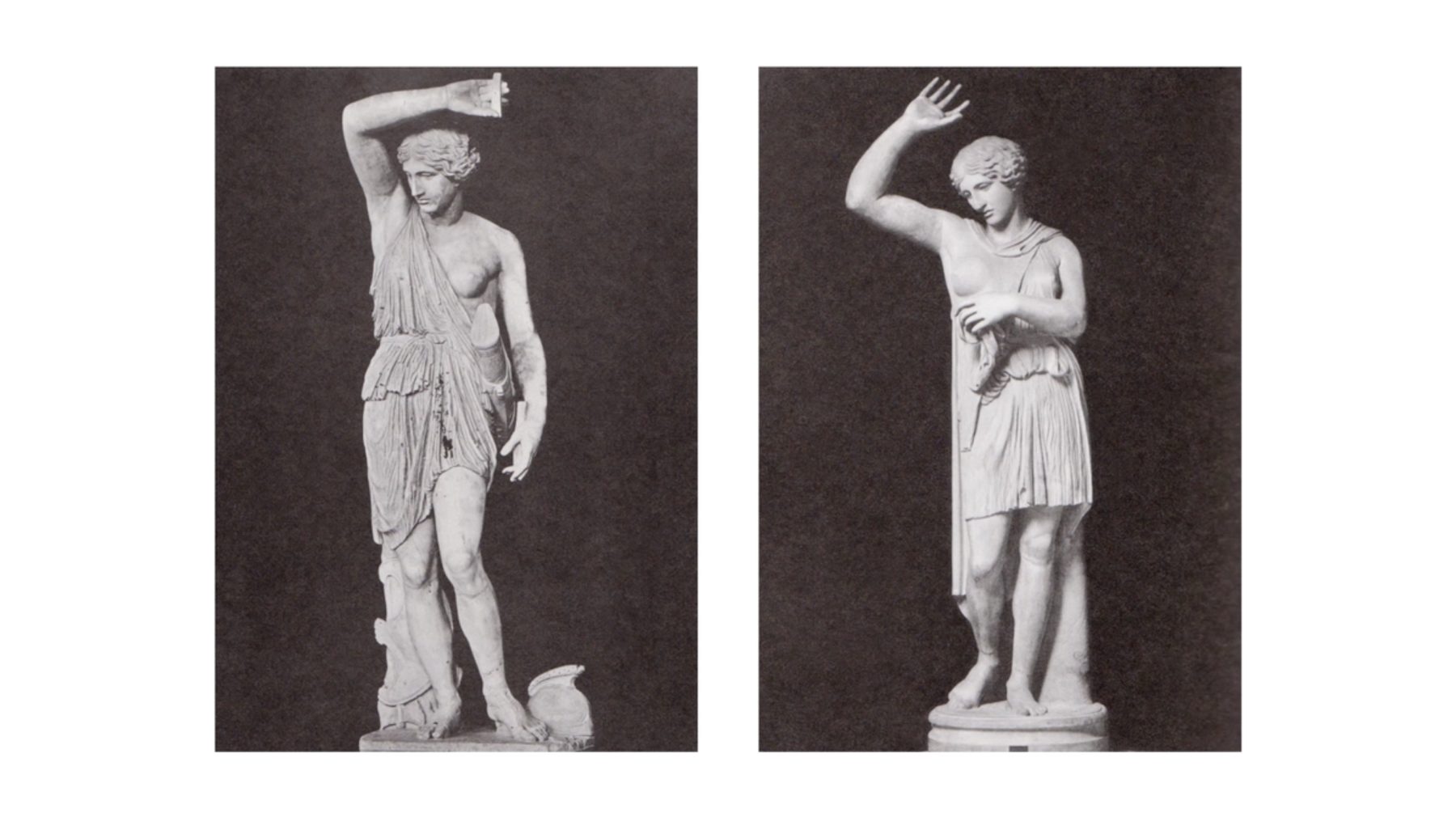
Critics have not remarked on the format of Versions, but it hardly seems coincidental that it closely resembles a traditional art history lecture with its narrated series of slide comparisons. Here I am reminded of Robert S. Nelson’s essay on the history of the art history slide presentation as a pedagogical performance developed in late nineteenth-century Germany that was closely entwined with the emergence of new optical media and the conditions of technical reproducibility.[29] Although over twenty years old, Nelson’s concluding question for the future of the field remains strikingly salient: “Where will the art historian stand in cyberspace, and what codes, disciplinary, performative, or otherwise, will control the content and guarantee the reliability of art presentations?”[30] There are, of course, whole teams of professionals within art history departments and libraries whose job is to safeguard and maintain this content and its metadata while ensuring its accessibility, at least within the considerably high paywalls of institutional affiliation (that being said, in my many years of teaching, the “best” image was always the one plucked from Google mere minutes before class was supposed to begin). But as Hito Steyerl observed in her superb essay “In Defense of the Poor Image” (2009), degraded images wander through the digital ecosystem like a disenfranchised proletariat, yet are no less “real” for all that.[31] Versions addresses all of these anxieties about the reliability of images head-on, if only by parroting them back in a feedback loop of decontextualized, unattributed quotes (from the likes of Joseph Koerner, Susan Sontag, Vitruvius, Michel Foucault, Elaine Gazda, among others) whose power derives from the effect that they sound like clichés in their new context. This effect is amplified by the style of narration: Laric hired an actress and asked her to read the script in such a way as to imitate the artificial sound of old speech-to-text computer software, further complicating the authorial signature of the video.
II.
All of these threads came together in Laric’s solo show Kopienkritik, curated by Raffael Dörig, which opened at the Skulpturhalle Basel summer 2011 (Fig. 7). Plaster casts of sculpture from the permanent collection were reinstalled and clustered in suggestive groupings that highlighted, with almost deadpan banality, their repetitive compositions at both identical and varying scales. Most of the sculpture comprises Idealplastik, but all of it regardless derives from Greek, rather than Roman, origins including not only Classical, but also Archaic and Hellenistic works. The title of the show derives from the aforementioned practice of Meisterforschung developed by Adolf Furtwängler in his seminal Meisterwerke der griechischen Plastik (1893).[32] The basic principle on which this method was founded is philological and unabashedly positivist: the stemma codicum, having entered scholarly convention in the first half of the nineteenth century, which was essentially a family tree used to depict differences among extant manuscript copies.[33] Analogously, Furtwängler and his many disciples compared the extant copies of Greek sculpture (as well as photographs—Furtwängler’s magnum opus was also a watershed in its didactic use of photography) in order to discern their commonalities and differences.[34] Arriving thereby at the “correct” and ostensibly scientific appearance of the original in all its formal “purity,” virtual representations were typically reconstructed in plaster and deposited in cast galleries for their educative value. That “purity,” of course, was devoid of color, despite the fact that polychromy was certainly a live issue at the time (Semper famously published on the role of polychromy in architecture, and Georg Treu, a classical archaeologist and curator at the Albertinum in Dresden, delivered a lecture entitled “Should Our Sculptures Be Painted?” just ten years prior to the publication of Furtwängler’s Meisterwerke). This should not be surprising, as Furtwängler and his acolytes remained staunchly devoted to Winckelmann, who famously extolled the whiteness of marble in classical sculpture despite being among the first to write about traces of its polychromy, thereby planting the seed for the racialization of stone and skin color.[35] At the root of the endeavor of Kopienkritik, therefore, was a desire to root out difference, whether in terms of composition, motif (e.g. an altered attribute), or color. Carlo Ginzburg, writing evocatively on the use of the stemma codicum that provided the model for this endeavor, has pointed up the epistemological value of these differences, variously termed “convergent” or “conjunctive” errors: “No norm can predict the full range of its transgressions; transgressions and anomalies, on the contrary, always imply the norm and therefore urge us to take it into account as well.”[36] It is impossible to imagine Furtwängler or any of his followers sharing Ginzburg’s valorization of the anomaly, but this is precisely what Laric’s work, organized by Dörig, sets out to explore.

7. Oliver Laric, Kopienkritik (installation photograph of the exhibition curated at the Skulpturhalle Basel in 2011 by Raffael Dörig. Courtesy of the artist and Metro Pictures, New York.
Building on the permanent collection of plaster casts, Kopienkritik presents both a translation and expansion of Ancient Copies into a Germanophone context. Severed heads of Heracles and Hermes have been scattered across the floor in the Skulpturhalle, alluding to the dispersal of copies both archaeologically and conceptually.[37] Color plays an important role here, too: Laric has cast these heads in stratified bands of polyurethane that gesture toward polychromy (the flatness of the colors, often favoring the primary colors, evokes the ostensible “garishness” of contemporary reconstructions) without making any claims to archaeological scientificity (Fig. 8).[38] As such, they pose a stark contrast to what Christopher S. Wood has vividly described as the “dread white army of Greek and Roman statuary, risen from the ground in the sixteenth century and then endlessly cloned and imitated, infiltrating first aristocratic homes, then the public spaces of bourgeois modernity.”[39] Indeed, it seems important that Laric builds color into the fabric of these sculptures, rather than applying it to their surface. Instead of “colorizing” them in the fashion of their scholarly reconstructions (of which many controversial versions of various types circulate; one could fairly call these reconstructions, however scrupulous, contemporary works of art in their own right), Laric emphasizes the ideological opacity of color, rather than its mimetic transparency. Color likewise operates invisibly at a more structural level in the scanning of sculpture. Far from being historically relegated to a bygone era of neoclassical color theory or twentieth-century art criticism, these resin-cast heads reveal how the relationship between form and color is very much alive in the digital era of 3D printing where .stl and .obj file formats predominate. Whereas .stl files (“standard tessellation language”) store information that is strictly limited to “describing” the surface topography, stitched together in the form of a point cloud to form a continuous polygonal mesh, .obj files, thanks to the lasers that simultaneously capture photographic information during the scanning process, can store information that includes the color and texture of the surface in question (the objects on threedscans.com include both .stl and .obj formats).
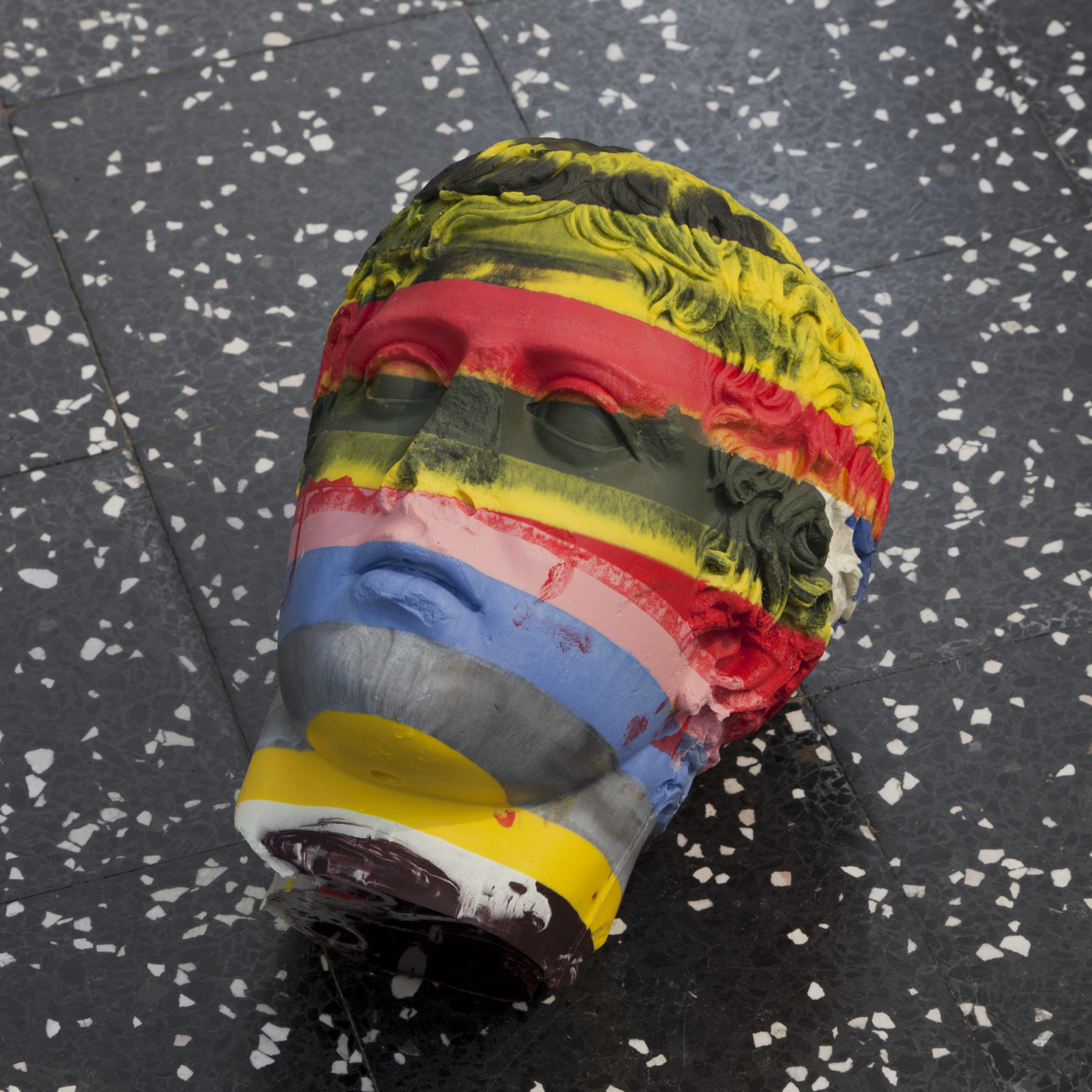
8. Oliver Laric, Hermes, presented in Kopienkritik (2011). Courtesy of the artist and Metro Pictures, New York.
Versions appears again here, this time projected onto the figures of two women in the so-called Severe Style, Aspasia and the Hestia Giustiniani, whose planar drapery—sculptors from this period favored the smooth peplos over the crinkly chiton—provides a suitable surface for a makeshift screen (once again, we might note the Semperian echoes in this technical remediation of textile). Dörig’s curatorial intervention here recalls the practice of “projection mapping” that transforms the three-dimensional, irregular topography of objects or even building façades into a usable display surface. The roots of this practice (one could also think of video and installation artists such as Bill Viola and Tony Oursler here), as Noam M. Elcott has shown, can be traced back to the eighteenth- and nineteenth-century attraction of phantasmagoria where spectral figures were projected onto scrims and screens occluded in darkness.[40] Elcott provocatively links these innovative screen effects to film critic David Denby’s account of “platform agnostics” in our contemporary relationship to screens, thus teasing out the multiple valences of “platform” (as I alluded to earlier with the pedestal, similarly reimagined here in the form of old CRT television sets displaying Laric’s early video work 787 Cliparts) as both an architectonic feature and a mechanical base for the operation of software.[41]
Laric has provocatively remarked that Versions remains in a permanent “beta-state originality,” a statement that alludes to the software release life cycle as well as the shadowy class of products called “vaporware,” a term first coined by a Microsoft employee in the early 1980s to describe software that is perpetually “stuck in the pipeline”—announced, but not yet commercially available either because it is only a concept or is still in development.[42] The link to software development is particularly suggestive in the way it encompasses the vast terrain of Laric’s body of work that ranges between the unique object produced for the market and the uploaded files that circulate freely on the Internet. Where do you first encounter an artwork? What “counts” as the primary or valid experience? These questions have driven Laric’s practice from the beginning, but were developed in creative collaboration with other artists. He, along with Aleksandra Domanović, Christoph Priglinger, and Georg Schnitzer who all studied at the University of Applied Arts Vienna, started an art blog called VVORK in 2006.[43] The site ran for nearly seven years until 2012, tallied over 5,000 posts, and boasted over 20,000 daily visitors at the height of its popularity. Today the domain (vvork.com) is defunct, but remains partially visible on archived pages. Unlike traditional art publications, VVORK promoted a more democratic ethos of distribution that cut across hierarchies in the art world so that established artists (whose work was often featured without the standard niceties of image permissions) could be shown alongside emerging artists. Sometimes described as a curatorial project or an autonomous artwork, VVORK’s founders have said that they considered it to be an ongoing exhibition. Unlike most other blogs at the time that were predominantly text-based, VVORK was almost exclusively visual save for brief captions and terms, many of which were tagged so that the site could also function as a searchable database. As Chloe Stead has keenly observed, the emphatically visual aspect of VVORK, combined with its infinite scroll feature (which was itself only invented in 2006), made it a veritable precursor to Tumblr, which appeared in 2007.[44] More than a merely biographical detail, VVORK laid the important groundwork for these artists, including Laric, to reimagine the extra-institutional stakes of control, accessibility and fair use in a distributive economy and ecosystem of digital information.
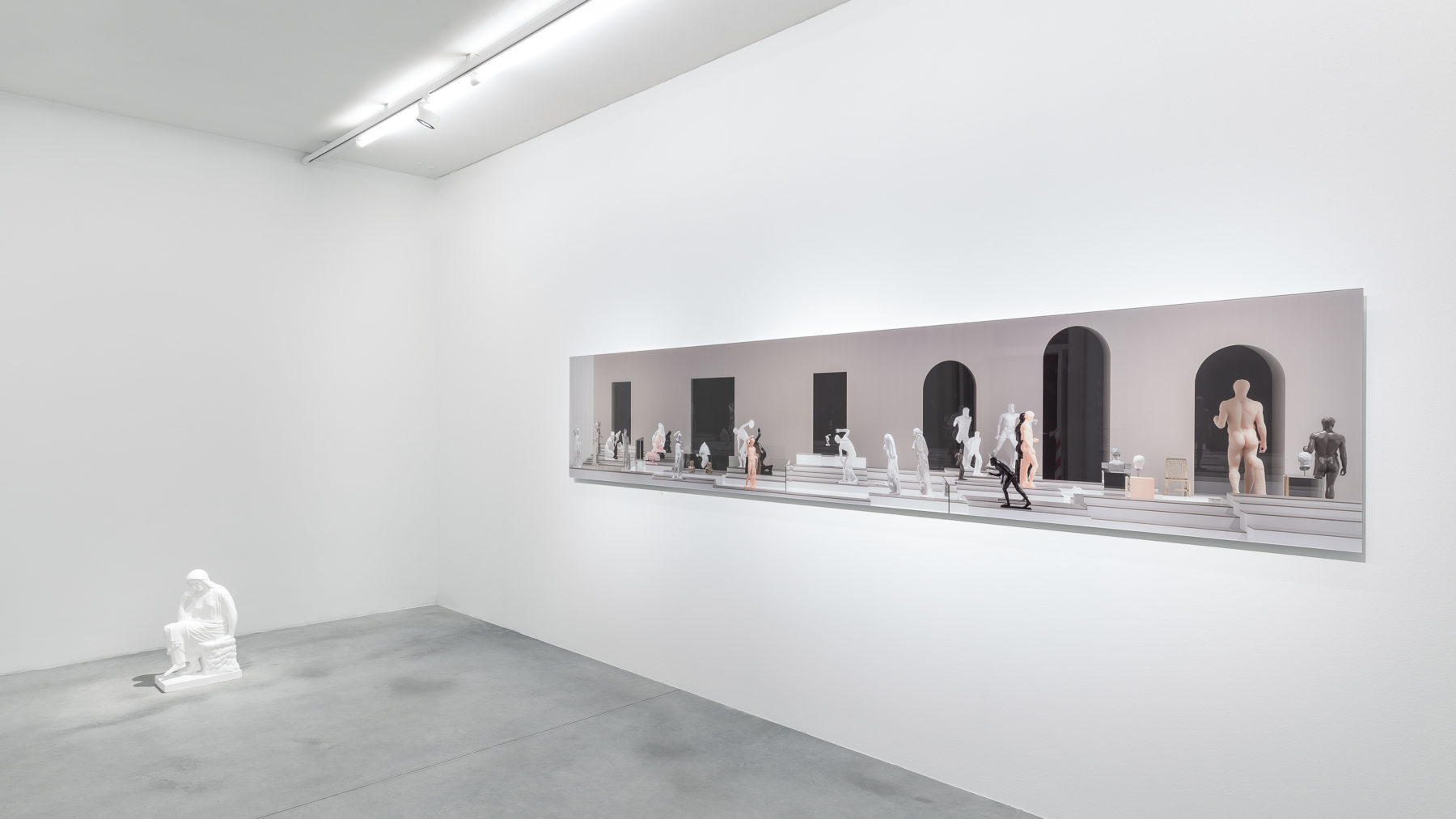
9. Oliver Laric, Serial Classic (2016), at the Fondazione Prada (Nord Gallery). Courtesy of the artist and Metro Pictures, New York.

10. Installation photograph of Serial Classic in 2015 at the Fondazione Prada (Podium). Photo: Attilio Maranzano. Courtesy Fondazione Prada.
III.
If legal quandaries of appropriation and even piracy hover productively in the background of much of Laric’s work, they became thematized in L’image volée (“The Stolen Image”), a group show organized by Thomas Demand at the Fondazione Prada in 2016.[45] Laric’s contribution was an installation entitled Serial Classic which featured an unusually wide diasec print as well as a polyamide 3D print of a seated Greek lady traditionally identified as Penelope (Fig. 9). Like Ancient Copies, the title Serial Classic is identical to its referent: the aforementioned exhibition organized by Salvatore Settis and Anna Anguissola at the Fondazione Prada the previous year. The print is a digital rendering of the central pavilion or “Podium” that housed the 2015 exhibition (Laric’s Serial Classic was installed steps away in the nearby Nord gallery), offering a panoramic view of Rem Koolhaas’ dazzling exhibition design that obscured the pedestals from view, effectively redistributing the sculpture flush with travertine floorplates set over acrylic slabs at various levels bordering at turns low-lying and floor-to-ceiling glass that reflected and amplified the vertiginous effect of the statues’ multiplicity (Fig. 10).[46] In a way, the diasec method of face-mounting in Laric’s print (in which photographic prints are attached to an acrylic sheet using a liquid gel adhesive) emulates what Koolhaas has called the “display landscape” of the exhibition. This is, at least in a rapid reading, what the print presents to the beholder.

11. Oliver Laric, Serial Classic (diasec print). Photo: http://oliverlaric.com/serialclassic.html.
And yet, the power of this print resides in the fact that it is not photographic, at least in any traditional sense having anything to do with old chestnuts like “objectivity” or “documentary,” even if it seems so on the surface (Fig. 11). Indeed, it evokes the uncanny effect of cloning algorithms used to populate architectural renderings. All of the sculptures, arranged here in almost frieze-like isocephaly, have been scanned and digitally inserted into a fictive ensemble and virtually relit (with corresponding ghostly shadows and reflections in the background) that approximate the installation shots of the original exhibition. They have also been colored black and white, brown and peach, beige and pink, in ways that suggest both sculptural polychromy and flesh. Amid the sculptures, Laric has also managed to smuggle in a number of easter eggs from his own work: scans of a crustacean and mollusk from threedscans.com; a chair featured in Versions. These digital strategies of synthetic multiplication recall techniques employed in early composite photography. In his discussion of Oscar Gustav Rejlander’s Two Ways of Life (1857), made from over thirty negatives, Jordan Bear situates the epistemological value of this composite image, or “combination” print, as it was called, in surprising relation to trade unionism, where “combination” carried strong connotations of the conspiratorial organization of labor.[47] As Bear reveals, Rejlander was eventually compelled to explain the technical aspects of facture behind his photographic prints, which obscured any traces of labor, the very thing they were meant to represent pictorially. Similarly, Laric’s print negotiates not only the contributions of the hand and the machine, but also the occlusion and documentation of labor across different platforms: although the print itself offers a seamless view of the Podium, Laric has uploaded images of the unprocessed scans of some of the figures (including the Pouring Satyrs) on his personal website, along with a photograph of an anonymous woman engaged in the process of scanning a marble statue of Aristogeiton (itself an amalgamation: the head, which was in the Vatican Museums, was attached to the body in the Capitoline Museums as recently as 1957) (Figs. 12-13).[48]
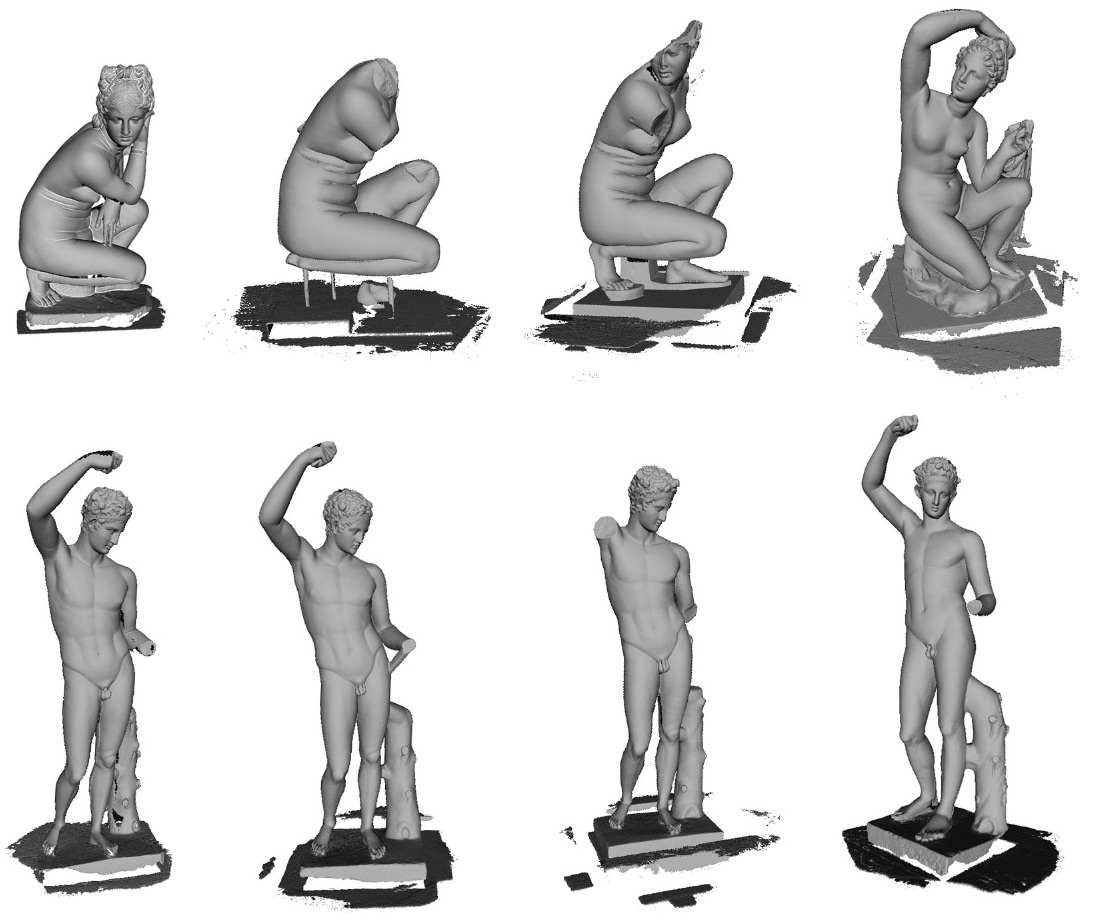
12. Oliver Laric, unprocessed scans of four versions of the Crouching Venus and the Four Pouring Satyrs from Castel Gandolfo. Photo: http://oliverlaric.com/serialclassic.html.
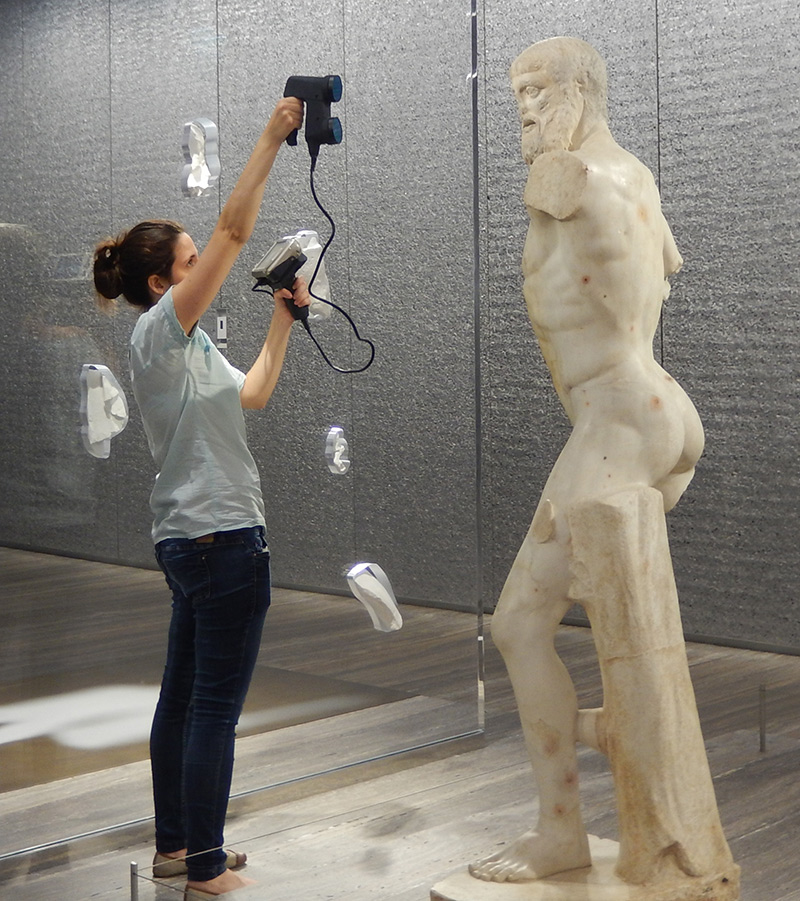
13. Scanning of the marble statue of Aristogeiton (body from the Capitoline Museums in Rome; the head is from the Vatican Museums and was joined to the body in 1957). Photo: http://oliverlaric.com/serialclassic.html.
I don’t know if Laric saw the Serial Classic exhibition in the summer of 2015 (I missed it, much to my enduring regret). But in many ways the issue seems beside the point. While autopsy (literally “seeing for oneself”) is standardly, and with good reasons, hailed as the supreme requirement for the inculcation of “close looking” in the art historical enterprise and its commitments to the materiality and immanence—some might even say auratic presence—of art, it also participates, almost stipulatively, in professional gatekeeping and establishing thresholds of accessibility more generally.[49] Laric’s experience in VVORK is relevant here insofar as it explored the very question of what “counts” as a legitimate or primary experience for viewing art. With respect to this very question, he has said: “I haven’t seen some of my favorite artworks, movies, or plays, nor have I read some of my favorite books, such as Cervantes’s Don Quixote, but my imagination of Don Quixote continuously influences my work.”[50] There are distinct echoes here of Sigmund Freud’s 1914 essay, “Remembering, Repeating, and Working-Through,” in which Freud famously asserts that the “compulsion to repeat” replaces the activity of remembering. The print, and Laric’s ethos behind it, likewise evokes Freud’s use of Raphael’s frescoes in the Stanza della Segnatura to illustrate the role of displacement in the dreamwork in The Interpretation of Dreams:
the dream does justice to the connection undeniably existing between all the pieces of the dream-thoughts by concentrating them into the unified representation of a situation or an event. It renders logical connections in terms of simultaneity; in doing so, it proceeds like the painter who assembles all the philosophers or poets to present a picture of the School of Athens or of Parnassus, for though they never gathered in one hall or on one mountain-top, they surely form a community in our thoughts.[51]
For Freud, the metonymic operations of displacement are “differently centered,” producing a disorienting synthesis or composite image (what Freud called Mischbildung with explicit reference to composite photography) in an uncanny weave of space and time.
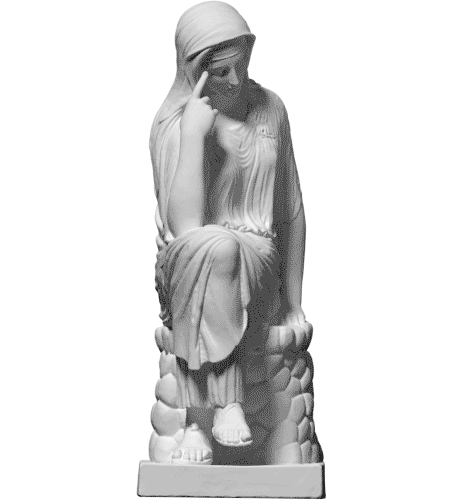
14. Oliver Laric, .obj file of a 3D scan of the plaster copy of Penelope in the Institut für Klassische Archäologie. Photo: http://threedscans.com/vienna/penelope/.
But if the composite fantasia of Laric’s Serial Classic evokes on one hand a simultaneous thought-community, its constituent figures suggest alternative displacements that operate across time. This is particularly evident in the figure of Penelope, situated in front of the print as if to extend the pictorial dimensions of its visual space into the real space of the gallery. The polyamide print derives from a scan of a plaster copy from the Institut für Klassische Archäologie in Vienna (Fig. 14). Several versions of Penelope were displayed in the 2015 Serial Classic exhibition; in his essay for the catalog, Tonio Hölscher unpacks the complex history of this sculptural type and its afterlives.[52] The “prime object” in the extant sequence of Penelopes is a fragmentary marble torso (along with a fragmentary right hand) now in Tehran at the National Museum of Iran. In 1936, archaeologists excavated the statue in the corridor of the Royal Palace at Persepolis, destroyed by Alexander the Great in 331 BCE. Curiously, however, a number of copies of Penelope were made in Rome during the imperial age despite the fact that the original at Persepolis, because it was buried in ruins, was clearly unavailable for consultation. To resolve this problem, Hölscher ingeniously proposed that a second original, contemporary with the one at Persepolis, was set up in Athens. The purpose of this doubling, he argued, was to offer a public exhibition to the citizens of Athens on one hand, and a diplomatic gift to the king of Persia in conclusion of the Persian Wars on the other. The figure of Penelope would have been a powerful symbol for both parties: just as Penelope waited for Odysseus fighting in the Trojan War and his extensive wanderings, so too did countless wives on both sides wait for their husbands to return from a war that had been raging for almost forty years. In light of this plausible reconstruction of events, Laric’s selection of Penelope seems particularly apt for his re-staging of Serial Classic: a duplicate Penelope, set up not in a different place, but in a different time—one that troubles the very notion of what we mean by a Greek “original” that was, at least in this case, always already plural.
But with Penelope—to loosely extend a Freudian approach that traffics in the risks and rewards of “overinterpretation”—there is also potential to detect a play on the slippage between l’image volée and l’image voilée (“the veiled image”) and the metaphorics of textiles. Much has been written in classical scholarship about the relations between “text” and “textile” with regard to Penelope’s stratagem for staving off her suitors by weaving a funeral shroud for Odysseus during the day and then undoing her progress each night. From a media-theoretical perspective, however, the connection to weaving is especially suggestive. As Bernhard Siegert, drawing once again on Semper, notes:
The textile image was always already a technological image because it was produced by the mechanical distribution of warps and wefts. It comes as no surprise that Alberti resorts to weaving and textile images when discussing the intricacies of central perspective. […] One example of many is his attempt to give a textile spin to Euclid’s definition of a surface: “If more lines stick together like close threads in a cloth, they will make a surface.”[53]
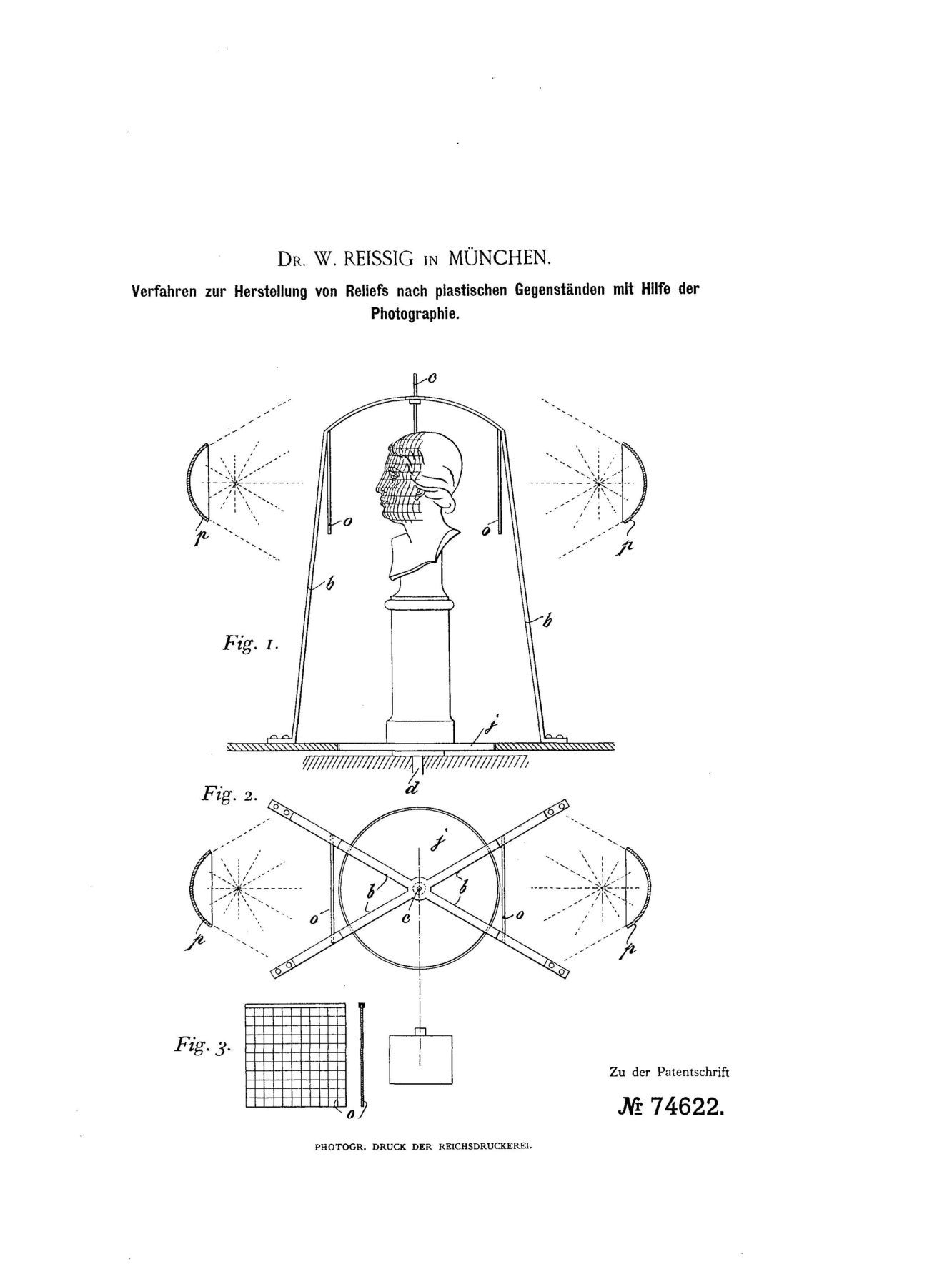
In addition to the link between weaving and perspectival construction—particularly apposite in the composition of the juxtaposed print—Alberti’s gloss on Euclid and the correlation between woven threads and surfaces evokes both historical and contemporary techniques of sculptural reproduction. As Jens Schröter has shown in his history of the “transplane image,” processes of rasterization, developed from Jacquard loom punch cards, played a key role in the invention of patented technologies in the late nineteenth century for registering the surface of sculpture by the projection of light through a grid (Fig. 15).[54] More recently, it recalls the data collected in scanning sculpture that is used to craft a polygonal “mesh” of a surface using grids of structured light. In contrast to the rasterization technique of the nineteenth-century device that sought to break the image down into smaller, more manageable bits of information (the precursor to modern raster graphics using bitmaps, or grids of individual pixels), digital scans of sculpture tend to use vector graphics comprising geometric primitives that are infinitely scalable without losing resolution.[55] At the same time, even vector graphics are subject to rasterization if they are to be displayed on digital screens. These matters of scalability only become more complicated once they are made to matter in the physical world—a problem that Laric explores and even thematizes in his latest sculptural work.
IV.
Laric’s recent sculptures have taken up increasingly daring and technically complex remediations of visibly compositive, disjunct bodies of printed plastic and cast resin (with various pigments and materials like powdered jade, bronze, and aluminum mixed or poured in to create aleatory effects) in various colors, textures, and grades of transparency. Following up on Penelope, I’d like to conclude, appropriately enough, with the figure of Odysseus: the subject of one of Laric’s most recent works entitled Ram with Human (2021) (Fig. 16). The omission of Odysseus from the title (at least in the unique piece; Laric retains it his uploaded version on threedscans.com) allows the work to circulate within a broader series of Laric’s investigations of animals and interspecies relationships and even eroticisms where, for example, the hybrid figure of Hermanubis—an ancient combination of the Greek and Egyptian gods Hermes and Anubis, respectively—commingles with furry fandom in contemporary kink culture (on this point, although no one talks about it in classical scholarship, Odysseus’ upside-down straddling of the ram’s loins is an outrageously erotic tour de force of classical sculpture). Ram with Human derives from a Roman marble sculpture dating to the second century CE in the Galleria Doria Pamphilj. A similar, yet more expressive version, formerly at the Villa Albani, can be seen in the newly restored and accessible Torlonia Collection.[56]
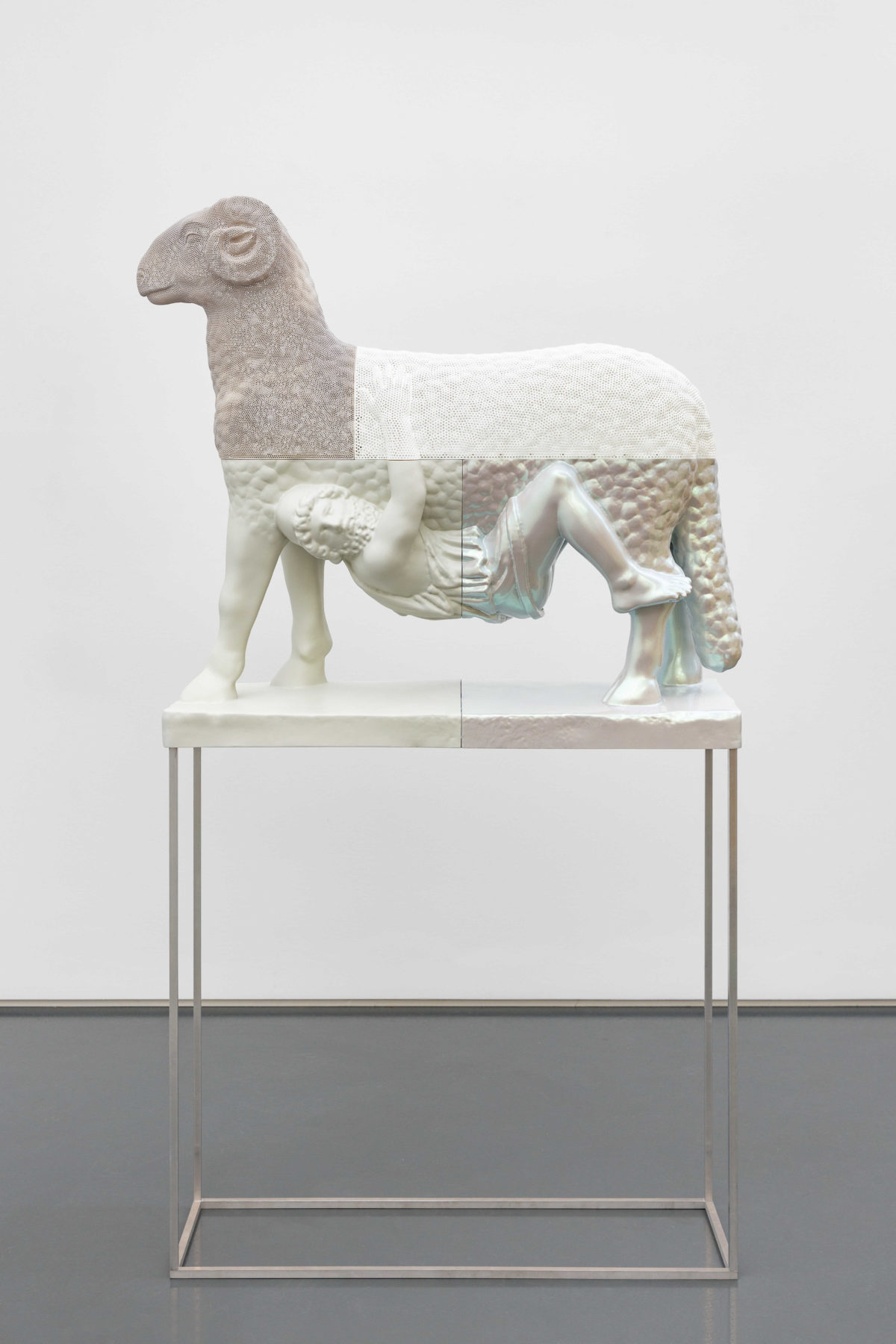
16. Oliver Laric, Ram with Human (2021). SLS nylon, SLA resin, pigments, paint, aluminum, 162 × 93 × 32 cm (with plinth). Photo: Bruno Lopes. Courtesy of Pedro Cera, Lisbon.
Formally, Ram with Human delights in the aesthetics of disjunction. 3D printed in both SLS (selective laser sintering) nylon and SLA (stereolithography) resin, it offers two distinct textures that are divided and distributed into unequal quadrants: the head of the ram, along with its back hindquarters, having a porous, mesh-like surface resembling a plastic speaker cover; and the front forelegs (and half of the human figure) and top of the ram’s back that have a contrastingly smooth, continuous surface. Color, too, is heterogeneous: the porous surfaces are off-white, the back of the ram is white, and the front forelegs and upper half of the figure exude a kind of milky, opalescent sheen. The explicit and even prominent display of seamed construction is a recurring feature of Laric’s sculptures over the past five years. Noting their appearance on Laric’s monumental reproduction of Max Klinger’s Beethoven, Luke shrewdly observes how “the raster pattern inscribes on the surface of the object a visible allusion to its origins in a virtual media environment structured by binary code.”[57] The reason for this, she explains, has to do with two different kinds of limitations: technical and institutional. The sheer size of Beethoven required it to be printed in twenty-five sections on account of the limit conditions of the scalar capacity of 3D printers. At the same time, the Museum der bildenden Künste in Leipzig refused Laric’s request to scan the sculpture, forcing him to digitally reconstruct the sculpture from photographs using photogrammetry software. In this case of the ram, however, the display conditions of the ancient sculpture posed a different set of challenges. Because the ram was set against the wall in the Galleria Doria Pamphilj, the back could not be completely scanned (Fig. 17). To solve this problem, Laric commissioned a digital sculptor to complete the photogrammetric rendering of the ram in post-production using evidence-based assumptions (Fig. 18).
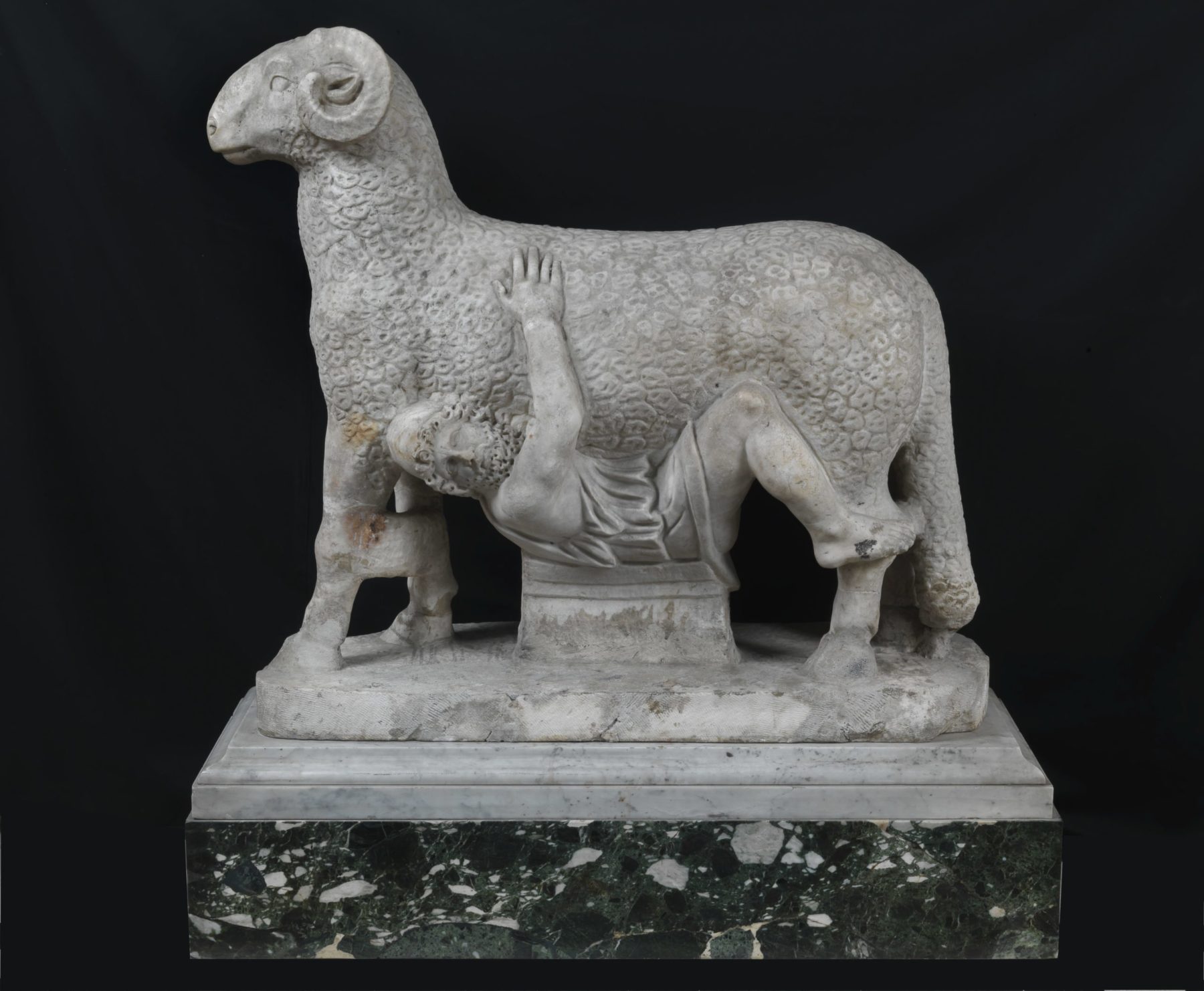
17. Odysseus holding onto a ram, marble, 2nd century CE. Rome, Galleria Doria Pamphilj.
18. Oliver Laric, video of photogrammetric scan of the Galleria Doria Pamphilj sculpture of Odysseus holding onto a ram. Digital sculpting by Benjamin Selwy. Courtesy of the artist and Metro Pictures, New York.
While the seams of Laric’s ram (and in many of his other works constructed in the same way) similarly allude to their origins in a “virtual media environment” as Luke suggests of Beethoven, I would add that they do so by recursively signifying seams that are produced in two different ways: the piecing of blocks of stone, and the making of plaster casts with the use of piece-molds. Laric’s conspicuous seams, I argue, operate as skeuomorphs: design features retained as “ornament” in new artifacts that had originally served a more structural purpose in prototypes made from different materials.[58] This is more or less straightforward in the piecing of stone masonry, but there are important distinctions to be drawn between stone that is carved on the ground in the workshop and that which is worked across the joins once the slabs, if left blank, have already been pried into place on the completed building (the north frieze of the Parthenon is a fine example).[59] Conversely, the seams can be seen as the indexical traces of piece-molds joined together so that, when removed to reveal the resultant cast, they must be sanded down to produce a smooth surface. What is particularly fascinating is the way in which this kind of cross-media transfer differs from classic examples of skeuomorphism like the transmutation of timber into marble in classical temple construction. For unlike the wooden beams that serve a structural purpose in the completed temple, Laric’s seams denote structuring processes rather than structure itself—processes, moreover, that were never meant to be visible in a lasting sense, that are black-boxed in the chains of operations in masonry or molding and casting.[60] Of course, there is a structural purpose to the piecing of plastic, owing to the physical constraints of how large the apparatus of the 3D printer can scale up. But it is clear from even a superficial glance at Laric’s pieced sculptures of irregular size and shape that their interlocking forms serve both structural and decorative purposes.
But if Laric introduced seams in order to point to older, artisanal modes of making, he likewise omitted other features that were critical to the physical structure of the sculpture in its original, antique state. This is evident in the wholesale deleting of the struts and supports of the ancient sculpture: the platform supporting Odysseus, and the bars connecting the legs of the ram. Such devices have long been reviled by modern beholders who have traditionally viewed them as unsightly detractions from essential form. Indeed, it used to be customary to cover them with black velvet for their photographic documentation.[61] Yet, as Anguissola has shown, the use of these supports in Roman marble sculpture plays a vital role not only in terms of their facture, but also within a broader discourse of sculptural aesthetics.[62] Sometimes, in fact, these supports perform no functional, structural purpose whatsoever: their conspicuous addition or inclusion suggests a more positive valuation in antiquity, for which there is ample evidence. For Pliny the Elder, one of the most astonishing technical achievements in the carving of marble sculpture is that which was made ex uno lapide, or “from a single stone.” Scholars have traditionally situated Pliny’s remarks within a discourse about the ostensible derivativeness of marble: the idea that it is derived from a prototype made in a different material, such as bronze. Anguissola, however, shows that thinking strictly in terms of derivation neglects the semiotic attribution of value to different sculptural materials, and indeed, the materialities of remediation itself. What all of this has to show in the case of Laric is how the omission of the supports evinces precisely the same technical bravura, but inverts the process through which the difficulty is measured. Whereas marble carving is a subtractive technique, 3D printing is additive: the assembly of the statue from different materials is in this case moredifficult than if it had been printed in a single process, from a single material.
Finally, there is the significant matter of Laric’s choice of motif in Odysseus and the ram. The subject, also represented in earlier Greek vase painting and small-scale ceramic and bronze figurines of the Greek and Roman eras, is drawn from Odysseus’ escape from the cave of the Cyclops Polyphemus in book 9 of the Odyssey. Trapped inside the cave of the savage one-eyed giant who has been greedily dining on his companions one by one, Odysseus devises a plan. After taking undiluted wine from Odysseus, the Cyclops drunkenly asks for the hero’s name; with characteristic cunning, Odysseus responds “Οὖτις,” meaning “nobody.” Later that evening, after Polyphemus had passed out, Odysseus and his men sharpened a wooden stake and thrust it into the giant’s eye, blinding him (his fellow giants, of course, fail to heed his cries for help because he says that “Nobody” is attacking him). The next day, Odysseus and his companions plot their getaway by tying themselves to the undersides of Polyphemus’ sheep, with a large ram for Odysseus himself. Polyphemus, now blind, lets the animals out to graze, feeling their backs to make sure the men aren’t riding them out of the cave. Upon realizing that he’d been tricked by Odysseus and his crew, an enraged Polyphemus hurls massive rocks at the departing ships.
Two aspects of the mythical episode seem especially salient here. The first is the invitation to align the obscured identity of a wily Odysseus as “Nobody” with the obscured identity of authorial signatures in Laric’s work (on this point, Laric himself has said that “I don’t see any necessity in producing images myself—everything that I would need exists, it’s just about finding it.”).[63] More interesting still are the suggestive relations between vision and touch. Homer’s pointed detail of the blinded Polyphemus feeling the shaggy backs of his sheep as they exit his cave to make sure that he hasn’t been duped by Odysseus offers a potent metaphor for the veridicality of sense perception. One wonders if it is merely a coincidence that the part of Laric’s ram that most closely resembles the ancient sculpture, both in terms of its outward appearance and texture, is the back of the ram. But in any case, the motif of the ram solicits thinking about how optical and haptic values map out onto the constituent elements of the sculpture (not only the quadrants of nylon and resin, but also the scanned information and digitally sculpted components, etc. etc.) that reveal how the discontinuities of digital modes of representation both replicate and correlate to the continuities of their analog counterparts.[64] In other words, it has to do with the difference between the continuity of the surface topography of a marble sculpture versus the discontinuity of a 3D printed one produced from a digitally sculpted scan of that same marble sculpture, recalling that digitally rendered scans of sculpture are ultimately complex polyhedrons, three-dimensional shapes comprising two-dimensional plane figures. The recursive processing of these distinctions between digital and analog modes of capturing and relaying information thus works to produce an effect of representation through elaborate chains of self-reference that foreground their mediality.
V.
If the romantic cult of the fragment wistfully sought to reassemble heterogeneous ruins into a cohesive whole, the postmodern fragment, as Gilles Deleuze and Félix Guattari insisted, aspires to no such hierarchical system of value: “We no longer believe in the myth of the existence of fragments that, like pieces of an antique statue, are merely waiting for the last one to be turned up, so that they may all be glued back together to create a unity that is precisely the same as the original unity.”[65] While this statement is often quoted to support a view of the postmodern condition as completely unmoored from the fixities or referents of the real world, such an excision is deeply misleading as it crucially omits the following qualification: “We believe only in totalities that are peripheral.” Here it is tempting to think about the status of the “peripheral” in the machinic philosophy of Deleuze and Guattari in a literal way: as the peripherals in computing (whether keyboards, speakers, or, especially in this case, the handheld scanning device) that together comprise the input and output signals of a given system. Metaphorically, the peripheral partakes in a posthumanist discourse that is historiographically linked to the history of cybernetics and, since the early 2000s, to Critical Animal Studies. It was precisely this critical lens that Rosi Braidotti adopted in her philosophical text associated with a gallery show of Laric’s sculptures of various human-animal interactions in 2015.[66] For Braidotti, Laric’s sculptural bodies express the conditions of “becoming nomadic” in a contemporary global context—posthuman, postidentitarian subjectivities that are non-unitary, unstable, polyvalent. At the same time, she stressed that the celebration of difference—whether that difference be sexualized, racialized, naturalized, etc.—entails an ethical dimension insofar as the dominant subject position epitomized by straight, white, able-bodied masculinity can all too easily veer into a kind of cosplay of difference.
All of these points are well taken and wholly apropos to a critical understanding of Laric’s work. But there are important differences that have gone unnoticed between this particular strand of posthumanist discourse developed in an Anglo-American context and what has been happening in so-called “German media theory” that also seem applicable to Laric and the Germanophone context of his artistic practice. Bernhard Siegert has lucidly laid out the historiographical stakes of these differences from the early 1980s through the present.[67] Whereas the American discourse favors a diachronic approach that presupposes an ontologically stable humanity that eventually became posthuman, its German counterpart asks how humans have always already commingled with the nonhuman, but with the important difference that the German nonhuman is defined through media technology, rather than biology.[68] Beginning with Friedrich Kittler, German media theory assumed an antihumanist position that took aim at the Enlightenment development of hermeneutic interpretation, an ideal system of meaning-making. Whereas meaning in this tradition is derived through philosophical idealizations, through a transcendental signified, Kittler insisted rather on the materiality of the signifier. He sought to show, in other words, that meaning can ultimately be traced back to empirical, historical objects in the world through media that, although they themselves are sense-less, are sense-making. Since the late 1990s, the field has shifted towards a more nuanced and expansive understanding of what count as media in the study of Kulturtechniken or “cultural techniques.” As Siegert defines it, cultural techniques are concerned at the most basic level with the production of differences through recursive chains of operations that, because they are processual, precede their ontological definitions. These chains of operations are recursive in the sense that they might begin as first-order techniques (e.g. ploughing a field) that can also perform symbolic work as second-order techniques (e.g. demarcating a sacred boundary), but might switch back and forth, thus drawing distinctions in the real or incorporating the symbolic into the real itself. What this means, Siegert shows, is that these media technologies can be both material objects and symbolic things that no longer have to play the foil to meaning. Thus cultural techniques are not antihermeneutic, as in the early phase of German media theory, but posthermeneutic.[69]
What might it gain us to think about Laric’s sculpture as “posthermeneutic”? With classical sculpture, and more particularly the case of Idealplastik, Laric provides himself with a fittingly ideal model for investigating the medial substrate of ideal (i.e. transcendental) systems that produce meaning. In sifting through the beautiful dross of copies and processing the media functions of their many differences and “conjunctive errors,” Laric engages not so much the practice of Meisterforschung, the search for the unique original, as the media-archaeological possibilities of discovery in the Forschung, the research, itself. Rather than pointing to some secure point of origin, to the prime objects of a given form-class, this research leads us instead into a spiraling labyrinth of referentiality that is perpetually deferred, never cohering or congealing around a stable meaning.[70] Perhaps, on account of its focus on technicity, we could say that Laric’s work cuts the gordian knot between formalism and iconography (or even between the “self-signals” of existence and the “adherent signals” of meaning, as Kubler once suggested). Indeed, Laric’s most radical move in the present context might lie in his processual, rather than ontological, definition of what counts as “classical” in the replica chains of its medial transformations. By repeatedly drawing attention to the media materialities of the classical ideal, Laric dislodges the classical from the very source of its enduring power and ideological might: its preeminence as a static, transcendental concept. In so doing, he reveals how the classical might be endlessly decoded and recoded—not simply in terms of a historically shifting terrain of meaning, as we might find in reception studies, but rather in the medial conditions of possibility for the production of meaning itself.
I wish to extend my most heartfelt thanks to Jennifer Nelson for her editorial guidance and the invitation to contribute to this special issue of Selva; to Anna Anguissola, Annetta Alexandridis, and Verity Platt for their help with images and for kindly reading earlier drafts of the essay; and finally to the anonymous readers for their incredibly generous, incisive, and thoughtful feedback. This essay is for my teacher, Elaine Gazda—a genuine article.
- [1] For a recent account of the Pouring Satyrs and their rich provenance history, see Anna Anguissola, “Osservazioni sul catalogo delle sculture di Dresda: il caso dei ‘quattro faunetti giovani antichi,’” Prospettiva: Rivista di storia dell’arte antica e moderna, 169/171 (2018), 221-225.
- [2] See especially Wilfred Geominy, “Zwischen Kennerschaft und Cliché. Römische Kopien und die Geschichte ihrer Bewertung,” in Gregor Vogt-Spira and Bettina Rommel, eds., Rezeption und Identität: Die kulturelle Auseinandersetzung Roms mit Griechenland als europäisches Paradigma (Stuttgart: Steiner, 1999), 38-58.
- [3] On the restorations, see especially the analysis of the Getty version in Erik Risser and Jens Daehner, “A Pouring Satyr from Castel Gandolfo: History and Conservation,” Studies in Conservation, vol. 51, supp. 2 (2006), 190-196.
- [4] This Satyr has traditionally been mounted on a pedestal that is actually a Roman altar formerly belonging to the collection of the Duke of Sutherland.
- [5] The landmark study is Richard Neudecker, Die Skulpturenausstattung römischer Villen in Italien (Mainz: P. von Zabern, 1988).
- [6] For a cogent introduction to Idealplastik, see especially Anna Anguissola, “‘Idealplastik’ and the Relationship between Greek and Roman Sculpture,” in Elise A. Friedland, Melanie Grunow Sobocinski, and Elaine K. Gazda, eds., The Oxford Handbook of Roman Sculpture (Oxford: Oxford University Press, 2015), 240-259. For revisionist accounts that, since the 1970s, have sought to bring greater nuance to the study of Roman versions of Greek sculpture, see especially Elaine K. Gazda, The Ancient Art of Emulation: Studies in Artistic Originality and Tradition from the Present to Classical Antiquity (Ann Arbor: University of Michigan Press, 2002); Miranda Marvin, The Language of the Muses: The Dialogue Between Greek and Roman Sculpture (Los Angeles: J. Paul Getty Museum, 2008); and Klaus Junker and Adrian Stähli, eds., Original und Kopie: Formen und Konzepte der Nachahmung in der antiken Kunst (Wiesbaden: Reichert, 2008); Verity Platt, “From Lost Original to Replica Series: New Approaches to Greco-Roman Multiples,” Perspective: Actualité en histoire de l’art 2 (2019), 165-178. Finally, for a superb account of the intermedial recursions in replication in Idealplastik, see Emily Margaret Cook, “Legacies of Matter: The Reception and Remediation of Material Traditions in Roman Sculpture,” Ph.D. diss., Columbia University, 2018.
- [7] See especially Janet Burnett Grossman, Jerry Podany, and Marion True, eds., History of Restoration of Ancient Stone Sculptures (Los Angeles: J. Paul Getty Museum, 2003).
- [8] Salvatore Settis and Anna Anguissola, eds., Serial/Portable Classic (Milan: Fondazione Prada, 2015). Cf. Anguissola, “Osservazioni sul catalogo.”
- [9] On the tension between the immediate appeal or shock of the iconography of contemporary figurative sculpture and its bracketability, see Hal Foster, Philosophical Objects: An Essay on the Sculpture of Charles Ray (published by Charles Ray Studio, 2019).
- [10] George Kubler, The Shape of Time: Remarks on the History of Things (New Haven: Yale University Press, 1962).
- [11] Adolf Furtwängler, Meisterwerke der griechischen Plastik (Leipzig: Verlag von Giesecke, 1893); Christopher S. Wood, The Vienna School Reader: Politics and Art Historical Method in the 1930s (New York: Zone Books, 2000).
- [12] On photosculpture, see especially Robert A. Sobieszek, “Sculpture as the Sum of Its Profiles: François Willème and Photosculpture in France, 1859-1868,” Art Bulletin, vol. 62, no. 4 (December 1980), 617-630.
- [13] On the relationship between analog and digital modes of representation and cultural techniques, see especially Whitney Davis, “How to Make Analogies in a Digital Age,” October 117 (summer 2006), 71-98, and Roger Moseley, “Digital Analogies: The Keyboard as Field of Musical Play,” Journal of the American Musicological Society, vol. 68, no. 1 (spring 2015), 151-228.
- [14] Gilbert Simondon, Individuation in Light of Notions of Form and Information, trans. Taylor Adkins (Minneapolis: University of Minnesota Press, 2020).
- [15] Gilbert Simondon, “Technical Mentality,” trans. Arne De Boever, Parrhesia 7 (2009), 24.
- [16] Margarete Bieber, Ancient Copies: Contributions to the History of Greek and Roman Art (New York: New York University Press, 1977).
- [17] Rosalind Krauss, “Sculpture in the Expanded Field,” October 8 (1979), 34. Cf. Rem Koolhaas, “The Socle and the Vitrine” in Settis and Anguissola, Serial/Portable Classic, 199-204, and Manuela Ammer, “The Pedestal Problem,” Frieze (Germany, Ausgabe 2, Autumn 2011), 60-69.
- [18] On “mediascapes,” see Arjun Appadurai, Modernity at Large: Cultural Dimensions of Globalization (Minneapolis: University of Minnesota, 1996). Megan R. Luke, “The Factotum of Industry: Max Klinger’s Beethoven,” kritische berichte, vol. 48, no. 3 (2020), 81-94.
- [19] Vito Adriaensens and Steven Jacobs, “The Sculptor’s Dream: Tableaux vivants and living statues in the films of Méliès and Saturn,” Early Popular Visual Culture, vol. 13, no. 1 (2015), 41-65.
- [20] Gottfried Semper, Style in the Technical and Tectonic Arts; or, Practical Aesthetics, trans. Harry Francis Mallgrave and Michael Robinson (Los Angeles: Getty Research Institute, 2004 [1860-1863]). Cf. the introduction in Bernhard Siegert, Cultural Techniques: Grids, Filters, Doors, and Other Articulations of the Real, trans. Geoffrey Winthrop-Young (New York: Fordham University Press, 2015), 1-17.
- [21] For the different versions of Versions (excluding versions that Laric himself did not create), see: http://oliverlaric.com/. Cf. https://anthology.rhizome.org/versions.
- [22] Domenico Quaranta, “The Real Thing: Interview with Oliver Laric,” Art Pulse (http://artpulsemagazine.com/the-real-thing-interview-with-oliver-laric).
- [23] Nelson Goodman, Languages of Art: An Approach to a Theory of Symbols (Indianaopolis: Bobbs-Merrill, 1968).
- [24] Goodman Languages of Art, 113.
- [25] Gregory Currie, An Ontology of Art (New York: St. Martin’s Press, 1989), 108.
- [26] Goodman, Languages of Art, 121.
- [27] Jason D’Cruz and P.D. Magnus, “Are Digital Images Allographic?,” Journal of Aesthetics and Art Criticism, vol. 72, no. 4 (fall 2014), 417-427.
- [28] Simondon, “Technical Mentality,” 24.
- [29] Robert S. Nelson, “The Slide Lecture, or the Work of Art “History” in the Age of Mechanical Reproduction,” Critical Inquiry, vol. 26, no. 3 (spring 2000), 414-434.
- [30] Nelson, “The Slide Lecture,” 434.
- [31] Hito Steyerl, “In Defense of the Poor Image,” e-flux 10 (2009) (https://www.e-flux.com/journal/10/61362/in-defense-of-the-poor-image/).
- [32] For a recent account of Furtwängler’s impact on modern classical archaeology, see especially Suzanne L. Marchand, “From Antiquarian to Archaeologist? Furtwängler and ‘Modern’ Classical Archaeology,” in Peter N. Miller, eds., Momigliano and Antiquarianism (Toronto: University of Toronto Press, 2007), 248-285.
- [33] See especially Philipp Roelli, Handbook of Stemmatology: History, Methodology, Digital Approaches (Berlin: De Gruyter, 2020), 209-225. I’m grateful to Jennifer Nelson for drawing my attention to this reference.
- [34] On the role of documentary photography in classical archaeology, see especially Stefanie Klamm, “‘Pictorial Silhouettes’ and Their Surroundings: Antique Sculpture and Archaeological Photography,” in Sarah Hamill and Megan R. Luke, eds., Photography and Sculpture: The Art Object in Reproduction (Los Angeles: Getty Research Institute, 2017), 50-66.
- [35] For a recent attempt to dislodge Winckelmann’s preference for white sculpture from the matter of race, see Lasse Hodne, “Winckelmann’s Depreciation of Colour in Light of the Querelle du coloris and Recent Critique,” Konsthistorisk Tidskrift/Journal of Art History, vol. 89, no. 3 (2020), 191-210. Although Hodne is correct that Winckelmann’s remarks on color are contextually separate from his remarks on race in the text, I disagree that this precludes any conceptual overlap between them, especially since Anne Lafont has shown how completely enmeshed the two had become in the discourse of painting in the eighteenth century. Cf. Anne Lafont, “How Skin Color Became a Racial Marker,” Eighteenth-Century Studies, vol. 51, no. 1 (fall 2017), 89-113 and, by the same author, L’art et la race: l’Africain (tout) contre l’oeil des Lumières (Dijon: les presses du reel, 2019). On the emergence and intersection of race and classicism in this historical context, see David Bindman, Ape to Apollo: Aesthetics and the Idea of Race in the 18th Century (Ithaca, NY: Cornell University, 2002).
- [36] Carlo Ginzburg, “Family Resemblances and Family Trees: Two Cognitive Metaphors,” Critical Inquiry, vol. 30, no. 3 (spring 2004), 537-556.
- [37] These heads recall a colorful replica series of medieval reliefs, targets of iconoclasm during the Reformation, that were neatly arranged on the floor like dominoes alongside Ancient Copies.
- [38] On sculptural polychromy in classical sculpture, see especially Vinzenz Brinkmann, Renée Dreyfus, and Ulrike Koch-Brinkmann, eds., Gods in Color: Polychromy in the Ancient World (San Francisco, CA: Fine Arts Museums of San Francisco, 2017).
- [39] Christopher S. Wood, “Reception and the Classics,” in William Brockliss et al, eds., Reception and the Classics (Cambridge: Cambridge University Press, 2011), 163-173.
- [40] Noam M. Elcott, “The Phantasmagoric Dispositif: An Assembly of Bodies and Images in Real Time and Space,” Grey Room 62 (winter 2016), 42-71.
- [41] David Denby, “Big Pictures,” New Yorker, 8 January 2007, 54ff. Elcott, “The Phantasmagoric Dispositif,” 50. Cf. Friedrich A. Kittler, “There Is No Software,” in John Johnston, ed., Literature, Media, Information Systems: Essays (Amsterdam: Overseas Publishers Association, 1997), 147-155.
- [42] Domenico Quaranta, “The Real Thing: Interview with Oliver Laric,” Art Pulse (http://artpulsemagazine.com/the-real-thing-interview-with-oliver-laric).
- [43] See Lauren Cornell and Ed Halter 2015 and Chloe Stead, “Oliver Laric: The Ghosts of Property,” Spike Art Magazine (winter 2018), 96-103.
- [44] Stead, “Oliver Laric,” 97.
- [45] Thomas Demand and Chiara Costa, eds., L’image volée (Milan: Fondazione Prada, 2016).
- [46] Koolhaas, “The Socle and the Vitrine.”
- [47] Jordan Bear, Disillusioned: Victorian Photography and the Discerning Subject (University Park, PA: Pennsylvania State University Press, 2015), 32ff. Cf. Georges Didi-Huberman, “People Exposed, People as Extras,” trans. Shane Lillis, Radical Philosophy 156 (July/August 2009), 16-22.
- [48] On this Aristogeiton, see especially Settis and Anguissola, Serial/Portable Classic, 223 no. 44, and Brunella Germini, Statuen des strengen Stils in Rom. Verwendung und Wertung eines griechischen Stils im römischen Kontext (Rome: L’Erma di Bretschneider, 2008), 27-42, 189-191, no. 12.
- [49] Sam Rose, “Close Looking and Conviction,” Art History, vol. 40, no. 1 (February 2017), 156-177.
- [50] Cornell and Halter, “Oliver Laric,” 110.
- [51] Sigmund Freud, The Interpretation of Dreams, trans. Joyce Crick (Oxford: Oxford University Press, 1999), 662-663.
- [52] Tonio Hölscher, “Wandering Penelope: Multiple Originals in Classical Greece,” in Settis and Anguissola, Serial/Portable Classic, 119-123. For an expanded version, see Tonio Hölscher, “Penelope für Persepolis, oder: Wie man einen Krieg gegen den Erzfeind beendet,” in Jahrbuch des Deutschen Archäologischen Instituts 126 (2011), 33-76.
- [53] Siegert, Cultural Techniques, 99. Cf. Leon Battista Alberti, On Painting, trans. Rocco Sinisgalli (Cambridge: Cambridge University Press, 2013), 23.
- [54] Jens Schröter, 3D: History, Theory, and Aesthetics of the Transplane Image, trans. Brigitte Pichon and Dorian Rudnytsky, revised by Jens Schröter (London: Bloomsbury, 2014), 110-112. Thanks to Jens Schröter for sharing this image with me.
- [55] On the importance of scale with particular reference to techniques of molding and casting in contemporary sculpture, see especially Glenn Adamson and Joshua G. Stein, “Imprints: Scale and the Maker’s Trace,” in Jennifer L. Roberts, ed., Scale (Chicago: Terra Foundation for American Art, 2016), 28-63.
- [56] See especially Maura Giles-Watson, “Odysseus and the Ram in Art and (Con)Text: Arthur M. Sackler Museum 1994.8 and the Hero’s Escape from Polyphemus,” Harvard Studies in Classical Philology 103 (2007), 555-577.
- [57] Luke, “Factotum of Industry,” 82.
- [58] On the intermedial operations of skeuomorphs, see especially Stephen A. Houston, The Life Within: Classic Maya and the Matter of Permanence (New Haven: Yale University Press, 2014), 52-73. On seams, I am reminded of this quote from Charles Ray: “Sculpture and seams are like boxers and broken noses: They go hand in hand.” https://www.nytimes.com/2018/05/13/arts/design/ charles-ray-sculpture-matthew-marks-gallery.html (May 13, 2018; accessed October 12, 2021).
- [59] See especially John G. Younger, “Work Sections and Repeating Patterns in the Parthenon Frieze,” in Michael B. Cosmopoulos, ed., The Parthenon and Its Sculptures (Cambridge: Cambridge University Press, 2004), 63-85. Thanks to Seth Estrin for drawing my attention to this reference.
- [60] Georges Didi-Huberman, La Ressemblance par contact: archéologie, anachronisme, et modernité de l’empreinte (Paris: Les Editions de Minuit, 2016).
- [61] Anna Anguissola, Supports in Roman Marble Sculpture: Workshop Practice and Modes of Viewing (Cambridge: Cambridge University Press, 2018), 16.
- [62] Anguissola, “Observazion sul catalogo.” Anguissola’s monographic treatment of marble supports builds on the pioneering work of Mary B. Hollinshead, “‘Hair Struts in Late Roman Sculpture’, in Kim J. Hartswick and Mary C. Sturgeon, eds., Stephanos: Studies in Honor of Brunilde Sismondo Ridgway (Philadelphia: University of Pennsylvania Museum of Archaeology and Anthropology, 1998), 119-130 and, by the same author, “Extending the Reach of Marble: Struts in Greek and Roman Sculpture,” in Elaine K. Gazda, ed., The Ancient Art of Emulation: Studies in Artistic Originality and Tradition from the Present to Classical Antiquity (Ann Arbor: University of Michigan Press, 2002), 117-152.
- [63] Quoted by Petra Cortright in 2008: https://rhizome.org/editorial/2008/jun/12/net-aesthetics-20-the-long-of-it/.
- [64] I am deeply indebted here to Whitney Davis’ concept of “new analogy.” Davis, “How to Make Analogies,” 98.
- [65] Gilles Deleuze and Félix Guattari, Anti-Oedipus: Capitalism and Schizophrenia, trans. Robert Hurley, Mark Seem, and Helen R. Lane (London: Bloomsbury, 2004), 45.
- [66] Rosi Braidotti, “Metamorphic Others and Nomadic Subjects.” The text was released as a kind of press release associated with the show and is accessible on several webpages: https://www.artforum.com/uploads/guide.002/id30563/press_release.pdf (accessed July 16, 2021).
- [67] Siegert, Cultural Techniques, 2-17.
- [68] Siegert makes the provocative point here that whereas the American discourse examines animals from the perspective of bioethics, cultural techniques considers instead the “media functions of animals—that is, with the way in which concrete cultural techniques such as domestication and breeding, sacrificial practices, and killing methods, in connection with the emblematization of certain medial virtues and capabilities of animals, serve to create, shift, erode, and blur the anthropological difference.” Siegert, Cultural Techniques, 8.
- [69] This distinction between “antihermeneutic” and “posthermeneutic” is Siegert’s. Cf. David E. Wellbery’s forward (“Post-Hermeneutic Criticism”) to Friedrich Kittler, Discourse Networks 1800/1900, trans. Michael Metteer, with Chris Cullins (Stanford: Stanford University Press, 1990), vii-xxxiii.
- [70] For a stimulating approach to handling matters of reference in premodern European art in the vein of Kubler, see especially Christopher S. Wood, Forgery, Replica, Fiction: Temporalities of German Renaissance Art (Chicago: University of Chicago Press, 2008).